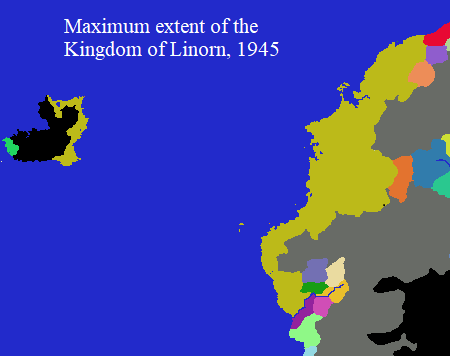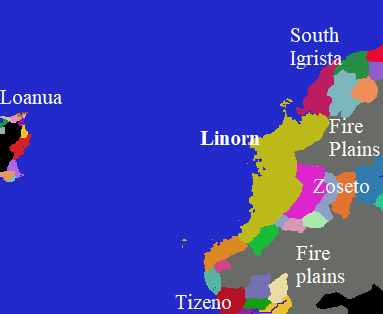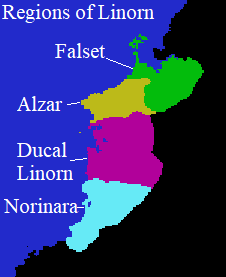Kingdom of Linorn
How to describe Linorn? It is the golden kingdom, the land of warriors and wine, masters of the Western coast of the Fireplains of Garadel. Their ritually scarred warriors are famous across the continent, and the kingdom is famous as much for its fierce discipline as its exaggerated pageantry. They claim to control the seasons by turning the very wheel of time and space, just as they claim to be able to slay ghosts - they certainly have a flair for dramatic boasts.
A century ago, they were seemingly unstoppable conquerors that seemed certain to conquer the Northwest of Garadel. A series of rebellions in the 1950s diminished that reputation- and Glorious Linorn has been slowly declining ever since. While still led by fierce warriors with great wealth, Linorn's administration has become horribly corrupt and increasingly inefficient. Many of the great Magnate families operate basically independent of the monarch, the priests seem to be increasingly running the actual central government on their own, infighting has brought politics to a screeching halt, and tax loopholes bleed the treasury dry. Their grand conquests of the last few centuries have reduced all surrounding powers to rubble, so they still remain unchallenged, but one can't help but wonder where exactly the Kingdom is headed.
Structure
Linorn is a theocratic feudal monarchy, ruled by a divinely ordained monarch that rules over a cast of aristocrats that manage the land. These aristocrats are divided into four formal classes:
- Magnates: Magnate families are the great landowners and powerbrokers of Linorn, with special legally enshrined rights and obligations. There are thirteen formally titled Magnate families.
- Lords: The middle-lords manage smaller plots of land, cities, and low-level administration.
- Half-lords: Half-lords are local lords, managing a town at most but sometimes just a village and its surrounding farmland. Half-lords are somewhere between landlords and knights. Sometimes, actual formal local landowners can have more money and influence than their half-lords.
- Banners: Retinue knights and warriors, sometimes with small estates. To focus on war, not administration.
Culture
Food: Regimes of Sauce and Bread
Values and Styles
History
Ancient History
Transitional History
Modern History
Demography and Population
Territories
Linorn has 450 miles of coastline and stretches around 150 miles inland. It is broken into four regions: Falset and Alzar in the North, and True Linorn and Nonikar in the South. All of these are a blend between forest, plains, and Mediterranean climate, with a smattering of lakes throughout. A series of small mountain ridges shield Linorn from the greater fire plains of Tolzel.
Military
Linorn's military is drawn from and organized by its military aristocracy and religious structure. Most iconic is its heavy cavalry: the winged lancers of Linorn are a force to be reckoned with. That said, its light cavalry and cavalry archers are also top-notch. And to clarify, this isn't just horse cavalry, but Dire Hound cavalry as well. Most feared - perhaps moreso than even the winged lancers- are the Ghosteaters. The Ghosteaters are dire hound cavalry that ride a specific breed of ghosthounds. Unlike most kinds of cavalry, they are very lighthly armored and carry few weapons. Rather, ghosteaters are masters of the Way of the Open Palm. Using their magical abilities to intercept arrows and missiles, their lack of heavy equipment enables their hounds to sprint at ridiculous speeds. The Ghosteaters use this to hunt down and disable enemy cavalry- the hounds smashing into the mount while the monk does their best to launch the rider off.
The Way of the Open Palm is fairly popular among cavalry and infantry alike- it is considered to be an extremely honorable and war-like discipline. And yes, infantry, archers, and artillery are present in Linorn as anywhere else- despite the fetishization of cavalry, the army is willing to do whatever it takes to win. Primitive gunpowder weapons and dragon sorcerers are also common sights in Linoran armies, as are incendiary rockets.
Unlike the other fire-plains kingdoms, Linorn is unusually Dryad-heavy in its warrior-caste. The dryads of Linorn have thoroughly intermingled with humans- the aristocratic dryads are just as skilled in the horse and lance, and often join in on sporting hunts for meat they cannot eat.
Religion
Linorn is a very Saraka state, with the priesthood playing an active political role and the Arsha (regional head of the Sarakan temple) acting as a major court figure.
Sarakan temples often hold and work land (with associated peasants), and it is honorable and encouraged for extra noble children to join the priesthood.
Outside of the standard priesthood, the great mystery cults are held in great esteem and often receive great patronage from the monarchy as well as noble houses. The largest and most popular of these is that of Nitren the Season Turner: an ancient demigod monarch of a past world who is said to have invented both the seasons and the Way of the Open Palm. Nitrenite cultists are known for extreme body modification, mystical flagellation, and rigorous Open-Palm training. For this reason, the Cult is often contacted by those wishing to learn the Open-Palm arts. But the cult isn't just practical: they are turned to when seasons are too harsh, during flooding or drought, to "remove the spiritual blockage" that has disrupted the flows of nature. They often do this using controlled burns and large community ceremonies of sacrifice (to destroy the anchors of the old world, enabling the new). Cultists also preside over public ceremonies and are often invoked as symbols of royal semi-divinity.
Other relevant cults include that of Emeno the Laughing Sun, whose merry revelers are often asked to bless the vineyards and the horse stocks, and that of the Holy Geometry, patron of thinkers, merchants, and teachers.
Some twelve years ago, the priesthood and Cults began to rise more and more in immediate prominence. The most recent monarch, Queen Avina II, was moved by her overwhelming piety and hatred of actually ruling to grant great political power to the Arsha and to invite elder priests to fill out her royal council. The current Arsha, Elrosa of Igristal, has done her best to fix the half-functional administration, but has been condemned by many as an outsider, interloper, and wicked powerhungry politician. Her opponents have increasingly pivoted from the formal priesthood to the Cults.
Foreign Relations
Linorn is a dominant regional power with little direct competition. Rather than threaten the surrounding states, it simply collects some small amount of tribute and acts as the regional protector against (basically nonexistent) outside threats. The nearest equivalent power, the Holy Kingdom of Nalastra, is an ally of Linorn. Really the only external threat to be found are the tribes of the fire-plains, which are not currently united into any significant coalitions.
Agriculture & Industry
The majority of Linorn is devoted to herding and agriculture. Wheat is the staple crop, along with millet and amaranth. Grapes, olives, citrus, and apples are common side-crops, with large quantities of wine, cider, olive oil, and woad produced in rural estates. Bell peppers, squash, artichokes, and yams are common household products, as are home-spun goods. Sheep, horses, cows, dire hounds, and goats are commonly herded across the plains. Near lakes and the coastline, sugar is sometimes grown. The coast is also home to large fisheries and salt distilleries.
Lumber is also a common product and export. Specially designated sustainable Eucalyptus woods are curated for lumbering, as well as the farming of koalas for fur. Fire Termite colonies are also farmed and refined, often by specialist priest-run workshops. Silk and glass are also produced, often near towns.
Trade & Transport
Traditionally, the heart of Linorn's artisanal community have been the Guilds. These guilds are artisan-run associations, powerhouses in themselves that often focus on regulating who can practice their trade and preventing excessive competition. While guilds are currently not in the political vogue and have been the target of many harsh regulatory laws in the last few decades, they remain the heart and soul of the urban ecosystem.
Increasingly, local guilds have had to turn to merchant collectives under Magnate families to escape restrictive laws. These guild-merchant-magnate alliances have become known as the Great Cartels. While these cartels are fairly restrictive, this new change has actually caused the fairly conservative member-guilds to begin innovating and intermingling. Some have even formed anonymous associations for group investment and business- kind of like accidental crypto-corporations.
Education
Education is overwhelmingly religious here, with temple-run schools and tutors being the primary form of educational opportunity for all social classes.
"We Turn the Wheel, We Break the Foe"
Founding Date
1680
Type
Geopolitical, Kingdom
Demonym
Linoran
Government System
Monarchy, Theocratic
Power Structure
Feudal state
Currency
Garadek Gold Moons, Silver Suns, Copper Stars
Major Exports
Olive oil, wine, citrus, fish, lumber, apples, cider, peppers, silk, glass, sugar, cloth, horses, fire termite oil
Major Imports
Iron/steel, gems, precious metals, tar, stone
Official State Religion
Location
Neighboring Nations
Related Plots
Remove these ads. Join the Worldbuilders Guild






Comments